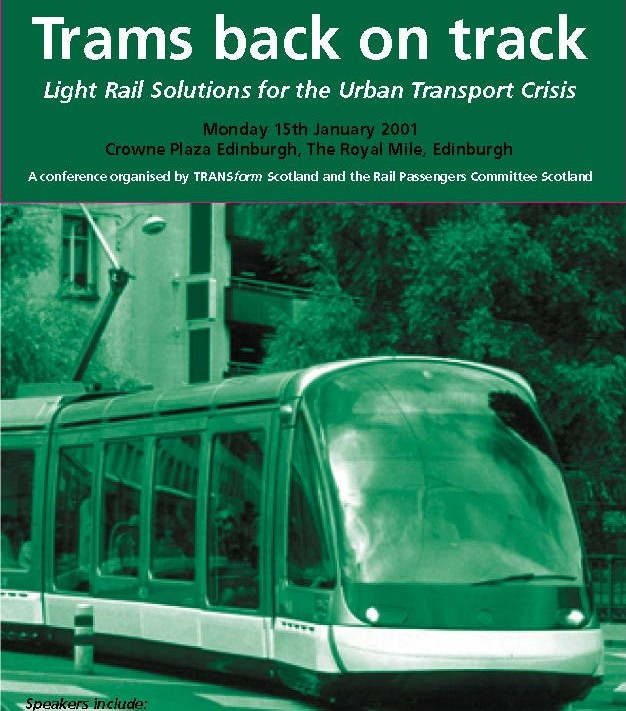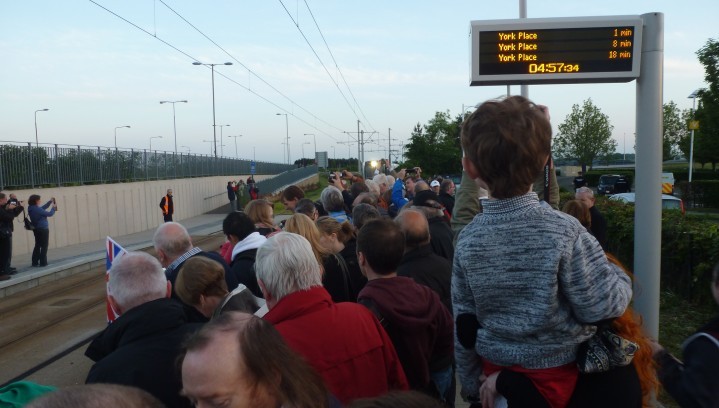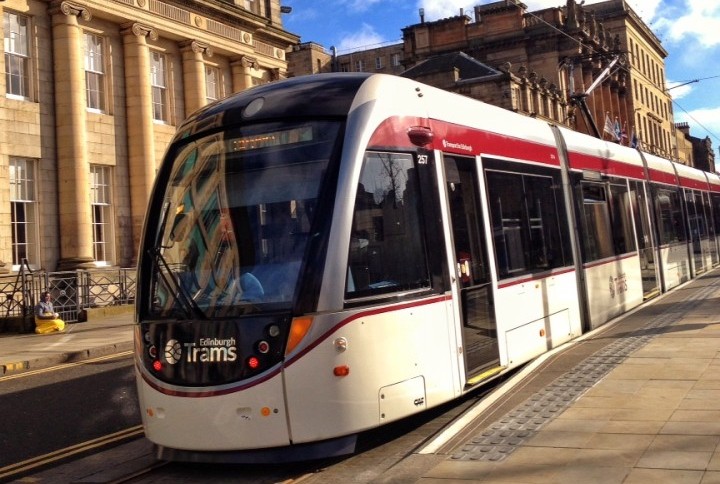Edinburgh’s trams from inception to successful launch
Transform Scotland board member Paul Tetlaw sets out a history of Edinburgh’s tram project and Transform Scotland’s role in ensuring its successful delivery.
The 2001 Trams Conference
The self-same issues were evident in Edinburgh with many areas grinding to a virtual halt at peak times as a tide of cars, mostly with only one occupant, descended on the city. It was clear that the much praised bus system would be unable to cope in the longer term with the predicted growth in people wishing to travel along key corridors into and across the city. Added to this were serious concerns about local air pollution and a general decline in the quality of life of those living and working in the city.
It was clear to us that a new generation tramway system would not only help to tackle the transport issues facing the city but would also put Scotland’s capital city on a par with others in Europe. It would help to attract jobs to the city, encourage regeneration in areas such as Leith and ensure that Scotland was seen as a modern progressive country in terms of public transport investment. It was also understood that trams would be much more likely to attract motorists to switch to public transport than buses.
Government Promises and the Parliamentary Process
It was with relief and delight that we heard on 4 March 2003 the Scottish Executive announcement that The City of Edinburgh would receive £375m for two tram lines. There followed a period of parliamentary scrutiny into the proposed tram lines one and two and we duly submitted evidence papers in favour of both tram line one and tram line two.
In this we highlighted the many benefits that trams would bring to Edinburgh and the need to integrate the tram system with the bus network and to provide for multi-modal ticketing. Following extensive scrutiny by the two Bill Committees, the Acts were duly passed for the construction of lines one and two.
City of Edinburgh full Council meeting in December 2006
After successful completion of the parliamentary process, the final decision on whether or not to proceed with the project lay with the City of Edinburgh Council. We gathered support from a wide range of organisations representing the business, retail, education, heritage, health, environment and transport sectors. In total 32 organisations added their support and we made a presentation at the full Council meeting on 21 December 2006 in support of the project. In advance of this we issued a briefing paper to all councillors.
The Council voted overwhelmingly to proceed with the project. It was noted at the time that the reasons for proceeding with the project were becoming ever more pressing and so we were then confident that the scheme would proceed and the benefits that we had long promoted would indeed be realised.
Parliamentary vote in May 2007
At the 2007 Parliamentary elections the SNP were elected as a minority government. The SNP made it clear that they did not see improvements in the public transport provision in the capital city as a priority and sought to cancel both the tram project and the Edinburgh Airport Rail Link (EARL). Whilst the latter had its critics it was wrong to describe it as being principally about connecting the capital to the airport as in reality it was more about connecting rail services across much of Scotland to the airport. EARL was duly cancelled but once again we mounted a campaign in support of the tram project with a list of supporting organisations. A further briefing paper was prepared, this time the list of supporting organisations was even longer, and it was issued to all MSPs on 23 May 2007. Following a vote in parliament the SNP accepted that as all other parties supported the scheme, believing as we did that Scotland’s capital city needed a light rail scheme comparable to competitor cities in Europe, that they would continue with the scheme.
Once again that appeared to settle the issue although John Swinney’s oft repeated phrase of “£500m and not a penny more” appeared at odds with the government’s support for road schemes some of which have run well over budget. Indeed the Aberdeen Western Bypass is currently around six times the original budget (£745m compared to the £120m figure when it first won Scottish Government support) and work has not yet started on the scheme. So it appeared that uniquely a cap was being placed on a public transport project while no such restriction was applied to any of the Government’s road-building schemes.
The Initial Construction Phase and the Problems
There followed an unhappy period for the project as the SNP withdrew the national transport agency Transport Scotland from the scheme and so their expertise and skills in handling large projects was lost. This left The City of Edinburgh Council and TIE (the City’s then transport delivery arm) to manage the project and the relationship with the contractors and as we now know this process did not go well.
Contractual disputes, delays and apparent poor quality workmanship all hampered the project. The media adopted a very hostile stance and not surprisingly the public mood began to swing against the project. It was particularly disappointing to see elements of the SNP government remaining hostile to the project while at the same time the government was allocating the £500m funds. It became clear during this period that Scotland’s reputation was being damaged while its capital city, far from stepping up to join the big league of European cities with light rail systems, was becoming something of a laughing stock.
City of Edinburgh full Council meeting in June 2011
Matters came to a head again in 2011 when following several years of stop/start construction and consequent budget overruns The City of Edinburgh Council found itself voting again on whether to continue with the project. Fortunately, in the end, the right decision was taken and the project continued, albeit with a curtailed route from the Airport to York Place. However, of greater importance was the fact that tram lines were built through the heart of the city from Haymarket to York Place thus paving the way for future extensions and potential tram train operations.
Once again we gave evidence at the full Council meeting and issued a joint briefing paper with Edinburgh Chamber of Commerce on 23 June 2011.
A new beginning
This time following an intervention from John Swinney – who was clearly concerned about the reputational damage to Scotland of the ongoing problems – Transport Scotland were brought back into the project and began to work closely with the Council. The contract was renegotiated and work began in earnest to complete the project. However, all did not go entirely smoothly and once again the quality of the workmanship was called into question as sections of road enclosing the tram track had to be dug up and re-laid.
Almost three years later and following exhaustive testing the first passengers were carried in May 2014.
Successful Public Opening on 31 May 2014
A historic moment as the first Edinburgh tram in 58 years approaches the platform just before 5am
The first public service was at 05:00 from the Gyle Centre to York Place and by 04:30 a large crowd had already gathered eager to be on the first tram. A crowded tram duly set out on its first public run and that first weekend over 40,000 people travelled on the new service. At the end of the first week around 130,000 people had travelled on the trams and the public mood has clearly shifted from hostility to acceptance and excitement about the chance to ride on the trams.
Many complimentary comments have been made including ones from those who had vowed never to use the tram. This appears to have surprised elements of the media and others who had been hostile to the project but comes as no surprise to us. The same pattern has been followed in other cities such as Dublin and Nice where there was a good deal of public discontent during the construction phase but this rapidly turned to support and demands for extensions. Those and the very many other cities with new generation tramways now view their tram networks as symbolic of a modern public transport system as well as helping them tackle the basic issues of congestion, poor air quality and aiding regeneration. There is no reason to believe it will be any different in Edinburgh.
Lessons Learned and What’s Next
For all the problems with the project it is clear that some key decisions can now be seen to have been critically important. The decision to create a new company – Transport for Edinburgh — and thereby integrate the trams with the already successful Lothian Buses will surely pave the way for integrated transport in the city and act as a model for others to follow. Equally the choice of trams with a large carrying capacity has already borne fruit as people have flocked to use the new services.
In terms of infrastructure, the fact that the new route traverses the city centre from Haymarket to York Place paves the way for future extensions and critically adds two extra rail tracks along the congested Haymarket to Waverley corridor. This will allow some future service extensions to be operated by tram-trains and at long last the under-utilised South Suburban Railway can start to play a real role in transport provision in the city.
As for next steps it is heartening to see that a consensus seems to be developing across the Council for extensions to the scheme. The absolute priority must now be to extend the route to Leith and beyond and start to unlock the regeneration potential in the Leith and Granton areas as well as servicing the heavily trafficked Leith Walk. Transport for Edinburgh have a depot and fleet of trams capable of operating extended services and the Council even have the new track ready to be installed. Beyond those initial extensions the route to the Royal Infirmary and adjacent BioQuarter should be developed as well as options for tram-trains.
In our view extension of the system should not be delayed by the judge-led inquiry announced by the First Minister on 6 June. Clearly it is important to establish the causes of the delays in construction and the roles of the key agencies and individuals involved:
- Why did the Government withdraw Transport Scotland from this major project of international significance?
- Why was the funding for this major public transport project so rigidly capped, no matter what adverse circumstances might arise?
- What was the purpose of this financial constraint, which seems to be unique, when so many road schemes have been allowed to over-run their initial budgets very considerably (e.g. the M74 extension and the Aberdeen western bypass)?
- To what extent were difficulties and additional costs in replacing utility services responsible for the protracted dispute between the Council and the Contractor?
- To provide a valid account of the cost of building the tram infrastructure, in terms of a significant long-term investment, the estimated costs of replacing the utility services, and the costs of the consequent delays, should be subtracted, as being a separate utility responsibility that had long been neglected.
Politicians of all parties might like to reflect on the above key issues. However, we will be willing to give evidence to the inquiry and trust that the terms of reference will allow for a close scrutiny of the part played by all players.
Tram at Saint Andrew Square. Photo by Douglas Jones; all other photos by Paul Tetlaw.





